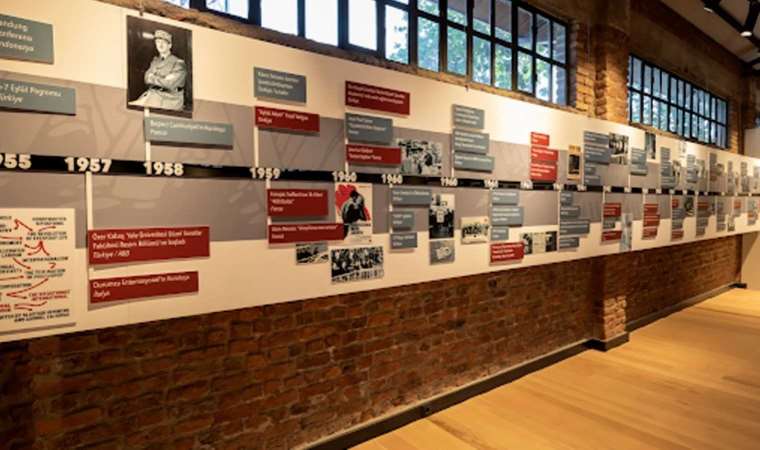Have you had the chance to visit the Yedikule Gasworks Hangar in Istanbul? I had not until this past weekend, but it boasts a rich history spanning 150 years. Constructed by the French in 1873, this gasworks facility, designed to illuminate around four hundred lighthouses and expand its gas supply capacity, was commissioned in 1880. Recently, the Istanbul Metropolitan Municipality, in collaboration with IBB Heritage*, has conducted a remarkable restoration of the Yedikule Gas House. It has transformed into a vibrant living space and cultural centre.
The first exhibition at this revamped site is titled "Long March 68." In tandem with this exhibition, the IBB Culture Department approached the PEN Writers' Union to host a discussion on "The Influence of the Spirit of Generation 68 on Literature and Art." Our second president, Halil İbrahim Özcan, and I found ourselves addressing an engaged young audience.
The Cultural Fabric of the 60s
Curated by Feyyaz Yaman, the "Long March 68" exhibition features works from 24 artists, all of whom, in one way or another, experienced the spirit of Generation 68. Some of these artists have passed away, while others still carry the torch of '68. Although not all the displayed works originate from that era, collectively, they offer a glimpse into the cultural fabric of the 1960s.
The artists featured in the exhibition (in alphabetical order) include Alaettin Aksoy, Asım İşler, Burhan Uygur, Cihat Aral, Zehra Aral, Sadık Karamustafa, Gülsün Karamustafa, Mustafa Ata, Nevhiz Tanyeli, Ömer Uluç, Özer Kabaş, Teoman Südor, Gülseren Südor, Komet, Koray Ariş, Ali Teoman Germener, Nur Koçak, Seyhun Topuz, Saim Bugay, Yüksel Arslan, Neşe Erdok, Balkan Naci İslimyeli, Kemal İskender, and Orhan Peker.
One of the highlights of the exhibition is a captivating chart that lines the walls. This chart encompasses a multitude of elements that captivate the interest of young visitors, including cultural, social, economic, and political transformations both globally and within Turkey. It also sheds light on the circumstances of the artists involved in the exhibition and those who were not. It delves into the realms of cultural and artistic production and the fervent endeavours of young individuals who claimed public spaces with enthusiasm.
Within this chart, you'll find names ranging from Che Guevara to Salvador Allende, from policemen to unionists, from Richard Nixon to Turkish politicians Bülent Ecevit and Süleyman Demirel. The chart also celebrates the presence of icons like the Beatles, Joan Baez, Bob Dylan, Jean-Paul Sartre, Simone de Beauvoir, Yaşar Kemal, Füruzan, Zülfü Livaneli, and Milliyet Art Magazine.
Moreover, two immense white screens positioned in the centre of the exhibition space serve as a dynamic showcase for the events of '68 worldwide and in our own country. They illuminate the transformations in social relations, the quest for renewal and rights, the pursuit of individual and social freedom, resistance, and the enduring enthusiasm and passion of that era, akin to scenes unfolding on a film strip.
I would like to congratulate those who prepared the exhibition, all the participants and those who contributed to it. Due to the overwhelming interest it has garnered, the exhibition's duration has been extended until October 31. It welcomes visitors every day from 10:00 AM to 6:00 PM, except on Mondays.
The Everlasting Spirit of '68
In our discussion, Halil İbrahim Özcan and I endeavoured to convey to the audience that the spirit of '68 remains indomitable.
We were young, idealistic, and believed we could change the world. Above all, "We aspired to the impossible while staying grounded in reality." Our mission was to eradicate fanaticism, racism, fundamentalism, nationalism, ethnicism, exploitation, and inequality. "Prohibition was prohibited." We aimed to dismantle oppression and totalitarianism. We refused to tolerate violence, armament, militarism, and war!
I underscored several key points, including the fact that the events of May '68, which evolved into a global epic, did not confine themselves to that year alone; they had roots reaching much deeper. They remain relevant even today. The revolutionary youth who symbolically pushed the US 6th Fleet out of Istanbul's Dolmabahçe, advocating for a "fully independent, democratic Turkey," drew inspiration from our War of Independence and Kemalism.
It's regrettable that while Turkish revolutionary Deniz Gezmiş, a symbol of '68, and his compatriots Yusuf Aslan and Hüseyin İnan faced execution, and another revolutionary leader Mahir Çayan was assassinated; the French symbol "Red Dany" (Daniel Cohn-Bendit) ascended as a political leader, eventually taking a seat in the EU Parliament.
The events of '68, aimed at political, economic, social, and cultural change, ignited a global conflagration. They permeated every facet of life, and during those years, art was the vessel of revolution—a creative act. That is precisely why totalitarian regimes feared the spirit of '68.
* IBB Legacy, founded in 2019 as part of the Istanbul Metropolitan Municipality Department of Cultural Heritage, has been dedicated to performing essential maintenance and repair tasks aimed at minimizing the necessity for extensive restoration in heritage zones.















